AI and start-ups are driving the maritime transformation.
HHLA wants to help shape the process and is trialling various concepts here.
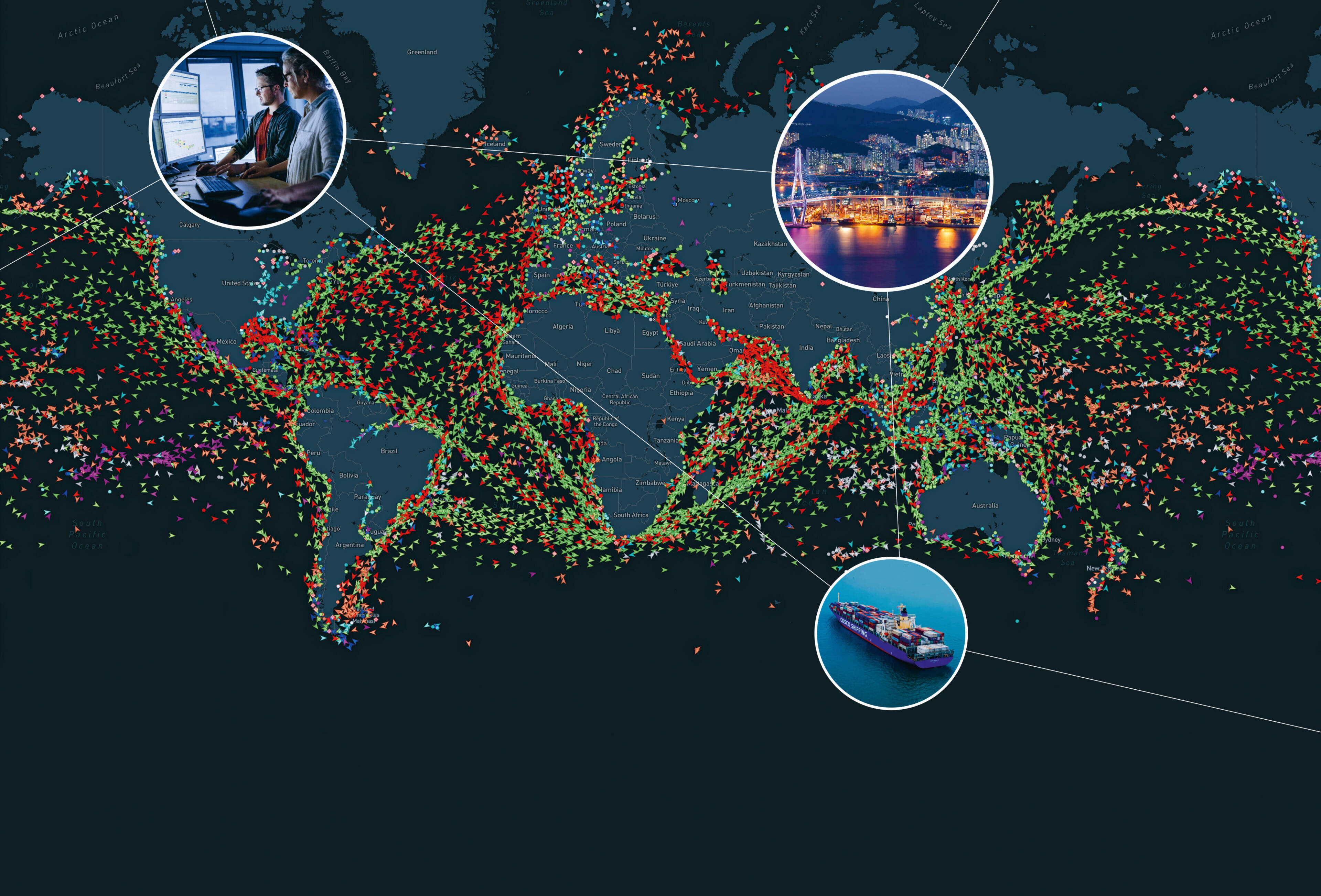
Around the globe, the digitalisation of maritime logistics is making headway – and data is now an indispensable part of the process. In South Korea, the Port of Busan manages a growing number of containers with its “Chainportal” blockchain platform, making it possible to share vessel details, berth statuses and truck locations, link terminal and forwarder data and allocate transport in advance. In Canada, the Port of Halifax relies on artificial intelligence to monitor emissions in real time using the AI platform “Data Enhancement Framework 2”. For greater resilience and energy savings, information constantly flows back and forth between the quay walls and ship decks.
These are but a few examples of how well connected the maritime industry is. It shares more and more data in real time, enabling better coordination of ships that call at numerous ports in succession or routes in container logistics that are planned across borders. Cosco freighters on the Asia–North Europe service from China, for example, dock at up to seven other ports before reaching Hamburg. With around 7,000 seagoing vessels arriving and departing every year, Hamburg is one of the best-connected ports in the world as a hub for the flow of goods from all international shipping routes. When it comes to digitalisation, Germany’s largest seaport is among the pioneers in automation, AI and data-driven processes.
Autonomous flights
HHLA Sky is not only developing safe industrial drones. Customers can also control them in large numbers with the Integrated Control Center.
As early as 1982, Hamburg’s port industry jointly initiated what was then a groundbreaking Port Community System (PCS), helping many players to collect data simultaneously and only once wherever possible. PCS platforms are now commonly used everywhere. Today, such digital solutions are developed by HHLA’s subsidiary HPC Hamburg Port Consulting – including PCS platforms for ports in Brazil, Georgia, Romania and Thailand. Then there are successful HPC projects in Europe and Asia for Maritime Single Windows, which serve as central platforms for the real-time exchange of regulatory, nautical and customs data.
In the Port of Hamburg, the HVCC Hamburg Vessel Coordination Center coordinates data from ships, terminals and other stakeholders via its port collaboration platform, the first of its kind in the world. Founded in 2004 as the Feeder Logistics Center (FLC), the HVCC has been a limited liability company since 2009 with HHLA as the majority shareholder. The next step in the digitalisation process is the web-based platform heyport. This scalable solution for straightforward ship calls and optimised berth planning can serve many ports. It provides information in one central place and establishes a digital handshake between shipowners, agencies and terminals. The start-up is part of the portfolio of HHLA Next, the investment and venture-building unit founded in 2021 that specialises in digitalisation and sustainability in maritime logistics. “We look for innovative business ideas and then found companies or invest in existing interesting start-ups,” says Simone Lode, Managing Director of HHLA Next. In 2024 alone, there were three spin-offs: besides heyport, there is also RailSync for rail management and the passify app for digital truck handling.



Hamburg is one of the best locations in Germany for start-ups
Start-ups are considered drivers of the digital transformation process. The young companies use disruptive technologies to develop innovative solutions and can react in an agile manner to changing requirements and unlock future markets. According to the “Hamburg Start-up Monitor 2025” produced by the German Start-up Association and the Hamburg Chamber of Commerce, there are 1,594 active start-ups in the Hanseatic city, placing it in the top three in the ranking of German cities.
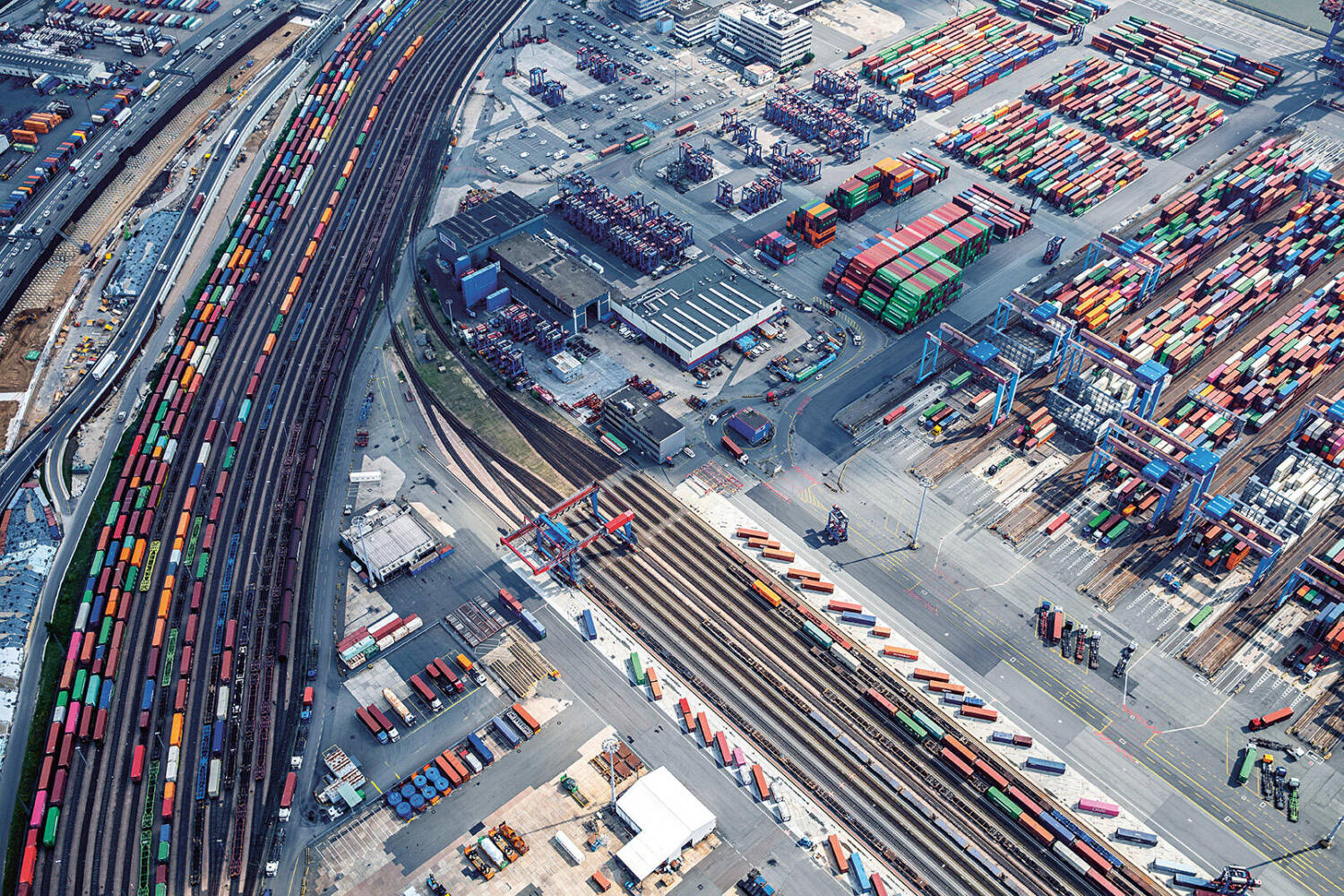
Forecasts
With the aid of AI, complex logistics scenarios can be better predicted, making it possible to optimise processes.
Another successful example is HHLA Sky. It has not only developed its own, safe industrial drones, but also the first scalable – and now multi-award-winning – drone control centre. The digital platform can also be used to control autonomous mobile robots in various locations around the world. HHLA is also testing AI applications, especially at its Container Terminal Burchardkai. As an example, Daniel Beck, a team leader specialising in data intelligence at HPC, mentions how forecasting the container dwell time can influence the stacking strategy: “If we know that a container will stay in the yard for several days, it can be stacked further down than one that will only be there for a few hours.” This saves a lot of manoeuvring and thus improves the carbon footprint. The carrier forecast for the onward transport of containers also determines the storage location and has the same effect.
“The focus in the future will be on further optimising the connection between maritime and continental logistics flows,” says Enrico Ramminger, Director Information Systems at HHLA. In the early years of IT, individual stand-alone solutions were developed for financial accounting, purchasing or operational processes. Nowadays, the emphasis is on consolidating, networking and evaluating data on a completely new scale, according to Ramminger. His department is currently testing the technology of a “data lakehouse” as part of a research project. This is a new kind of data architecture that facilitates machine learning while promising faster business intelligence and predictive analytics.
History of HHLA EDV-Technology read more
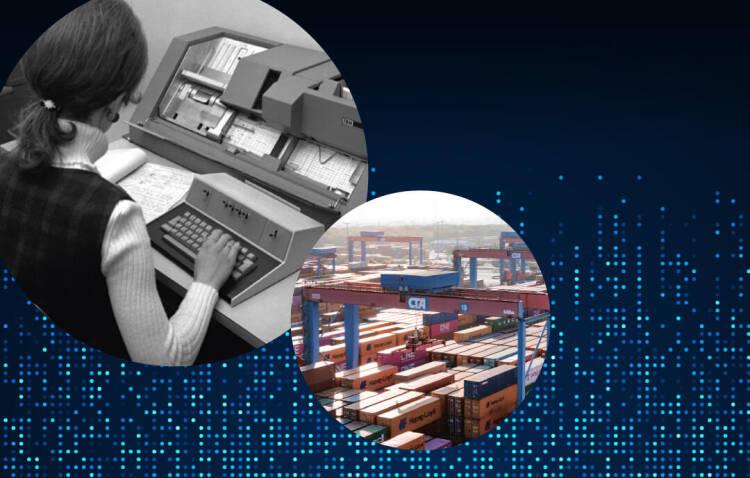

Hamburger Hafen und Logistik Aktiengesellschaft
Bei St. Annen 1
20457 Hamburg
Phone +49 40 3088-0
www.hhla.de/en
Responsible in terms of the German press law
Carolin Flemming, Head of Corporate Communications
→ Write e-mail
Photo credits
Adobe Stock, Sven Glage, HHLA, HHLA Sky, HPC, Nele Martensen, Thies Rätzke, vesselfinder.com, wikipedia/Nasa, Friedrich Zitte
Editor in chief
Christian Lorenz
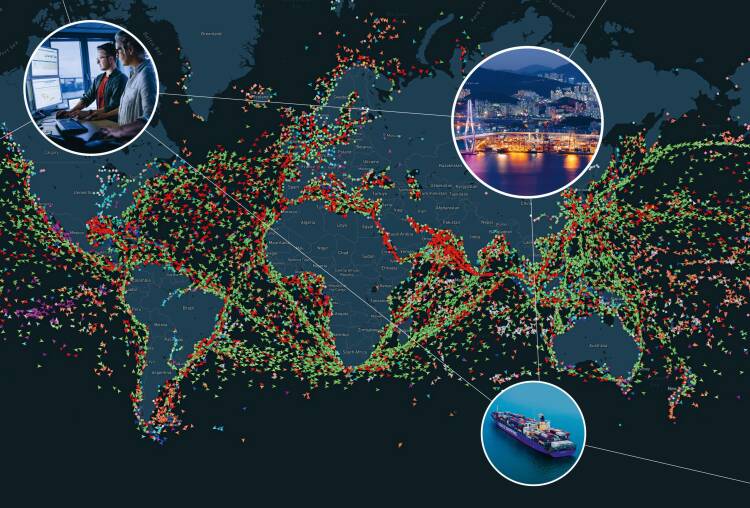
AI and start-ups are driving the maritime transformation. HHLA wants to help shape the process and is trialling various concepts here.
Around the globe, the digitalisation of maritime logistics is making headway – and data is now an indispensable part of the process. In South Korea, the Port of Busan manages a growing number of containers with its “Chainportal” blockchain platform, making it possible to share vessel details, berth statuses and truck locations, link terminal and forwarder data and allocate transport in advance. In Canada, the Port of Halifax relies on artificial intelligence to monitor emissions in real time using the AI platform “Data Enhancement Framework 2”. For greater resilience and energy savings, information constantly flows back and forth between the quay walls and ship decks.
These are but a few examples of how well connected the maritime industry is. It shares more and more data in real time, enabling better coordination of ships that call at numerous ports in succession or routes in container logistics that are planned across borders. Cosco freighters on the Asia–North Europe service from China, for example, dock at up to seven other ports before reaching Hamburg. With around 7,000 seagoing vessels arriving and departing every year, Hamburg is one of the best-connected ports in the world as a hub for the flow of goods from all international shipping routes. When it comes to digitalisation, Germany’s largest seaport is among the pioneers in automation, AI and data-driven processes.
Autonomous flights
HHLA Sky is not only developing safe industrial drones. Customers can also control them in large numbers with the Integrated Control Center.
As early as 1982, Hamburg’s port industry jointly initiated what was then a groundbreaking Port Community System (PCS), helping many players to collect data simultaneously and only once wherever possible. PCS platforms are now commonly used everywhere. Today, such digital solutions are developed by HHLA’s subsidiary HPC Hamburg Port Consulting – including PCS platforms for ports in Brazil, Georgia, Romania and Thailand. Then there are successful HPC projects in Europe and Asia for Maritime Single Windows, which serve as central platforms for the real-time exchange of regulatory, nautical and customs data.
Enrico Ramminger,
Director Information Systems at HHLA, on the new era:
“We are seeing exponential growth in the digitalisation of processes in terms of innovation, complexity and networking effects. Driven by the opportunities arising from digitalisation, we can automate more and more things, but also develop products and monetise certain data. This is a completely new era that affects every aspect of activities in the social and economic sphere.
By way of example, a data lakehouse is currently in the initialisation phase at HHLA. This represents a consistent approach to the ongoing development of our existing data warehouse and business intelligence structure, creating a central data pool across the entire Group and beyond. The data lakehouse can be used to optimise our operations and create AI solutions. In addition, we can use a platform ecosystem to deliver services and benefits to HHLA customers or introduce digital products.”

Wiebke Kropp-Büttner,
Managing Director at HHLA Sky, on digital solutions:
“Digitalisation will not only determine the future viability of drone logistics. Digital technologies are revolutionising the industry, making processes smarter and safer. Data and artificial intelligence are connecting all relevant players in real time, facilitating automated fleet management, intelligent route planning and real-time tracking. With our end-to-end approach, the HHLA Sky Integrated Control Center becomes a process management and digitalisation tool for mobile robot management. Through multi-drone operations, we are creating economic added value for our customers in the areas of transport, inspection, security and monitoring. Our aim is to establish HHLA Sky as an open standard for mobile robot management – based on our control centre as an automation platform for industrial Internet of Things devices and unmanned traffic management.”

Daniel Beck,
Team Leader Data Intelligence at HPC, on artificial intelligence:
“At Burchardkai, we are running an AI pilot project for volume forecasting at the rail terminal until the end of 2025 in order to optimise resource planning. We are taking into account internal movement data from the past to make a forecast for the next shift. We are enhancing it with external data. In the current pilot phase using generative AI, we are expecting the first results soon. We are examining how the ordering process at HHLA’s rail subsidiary Metrans can be optimised by automatically processing emails. In Hamburg, a project has been set up to assign voyage numbers to ship calls with the aim of populating automated databases.
In addition to the HHLA projects, we are building a data intelligence suite for logistics. Simulation applications and agents should be able to manage the process steps. The general trend is towards multi-agent systems in the office workspace. Shipping companies, freight forwarders and rail operators can use it to generate orders or complaints as well as draw up or check supplier contracts.”

In the Port of Hamburg, the HVCC Hamburg Vessel Coordination Center coordinates data from ships, terminals and other stakeholders via its port collaboration platform, the first of its kind in the world. Founded in 2004 as the Feeder Logistics Center (FLC), the HVCC has been a limited liability company since 2009 with HHLA as the majority shareholder. The next step in the digitalisation process is the web-based platform heyport. This scalable solution for straightforward ship calls and optimised berth planning can serve many ports. It provides information in one central place and establishes a digital handshake between shipowners, agencies and terminals. The start-up is part of the portfolio of HHLA Next, the investment and venture-building unit founded in 2021 that specialises in digitalisation and sustainability in maritime logistics. “We look for innovative business ideas and then found companies or invest in existing interesting start-ups,” says Simone Lode, Managing Director of HHLA Next. In 2024 alone, there were three spin-offs: besides heyport, there is also RailSync for rail management and the passify app for digital truck handling.
Hamburg is one of the best locations in Germany for start-ups
Start-ups are considered drivers of the digital transformation process. The young companies use disruptive technologies to develop innovative solutions and can react in an agile manner to changing requirements and unlock future markets. According to the “Hamburg Start-up Monitor 2025” produced by the German Start-up Association and the Hamburg Chamber of Commerce, there are 1,594 active start-ups in the Hanseatic city, placing it in the top three in the ranking of German cities.
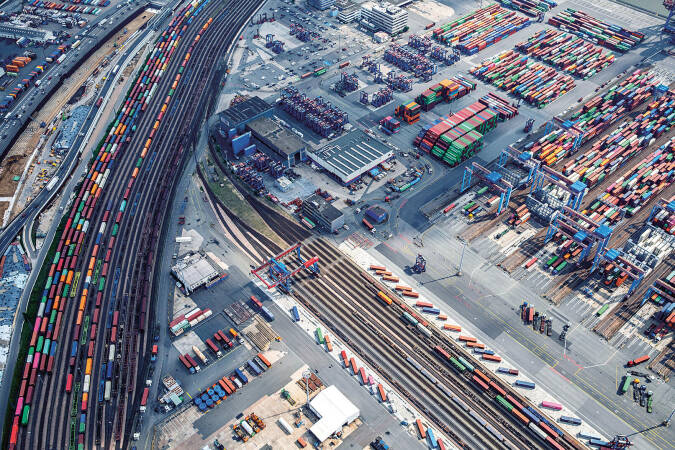
Forecasts
With the aid of AI, complex logistics scenarios can be better predicted, making it possible to optimise processes.
Another successful example is HHLA Sky. It has not only developed its own, safe industrial drones, but also the first scalable – and now multi-award-winning – drone control centre. The digital platform can also be used to control autonomous mobile robots in various locations around the world. HHLA is also testing AI applications, especially at its Container Terminal Burchardkai. As an example, Daniel Beck, a team leader specialising in data intelligence at HPC, mentions how forecasting the container dwell time can influence the stacking strategy: “If we know that a container will stay in the yard for several days, it can be stacked further down than one that will only be there for a few hours.” This saves a lot of manoeuvring and thus improves the carbon footprint. The carrier forecast for the onward transport of containers also determines the storage location and has the same effect.
“The focus in the future will be on further optimising the connection between maritime and continental logistics flows,” says Enrico Ramminger, Director Information Systems at HHLA. In the early years of IT, individual stand-alone solutions were developed for financial accounting, purchasing or operational processes. Nowadays, the emphasis is on consolidating, networking and evaluating data on a completely new scale, according to Ramminger. His department is currently testing the technology of a “data lakehouse” as part of a research project. This is a new kind of data architecture that facilitates machine learning while promising faster business intelligence and predictive analytics.
History of HHLA
EDV-Technology
read more
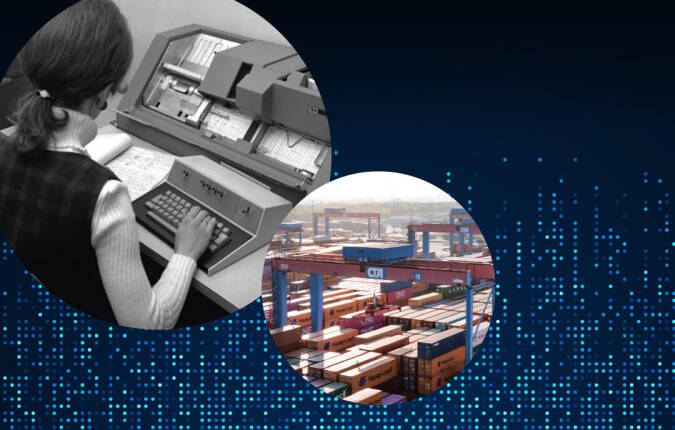

Hamburger Hafen und Logistik Aktiengesellschaft
Bei St. Annen 1
20457 Hamburg
Phone +49 40 3088-0
www.hhla.de/en
Responsible in terms of the German press law
Carolin Flemming, Head of Corporate Communications
→ Write e-mail
Editor in chief
Christian Lorenz
Photo credits
Adobe Stock, Sven Glage, HHLA, HHLA Sky, HPC, Nele Martensen, Thies Rätzke, vesselfinder.com, wikipedia/Nasa, Friedrich Zitte
